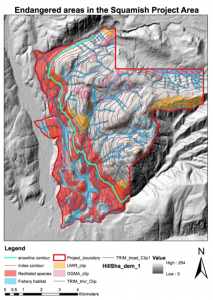
As a natural resource planner, I propose the Ski Hill project in Garibaldi at Squamish. The project is a year-round destination mountain resort which is going to construct a ski resort, ski accommodation, and the commercial developments in Garibaldi at Squamish. The project estimates will provide more than 900 constructions job opportunities and 2500 other jobs during the 20 years operation. In this proposed project, I am going to examine the feasibility of building a ski resort in Garibaldi at Squamish and its potential effects on old growth forest, ungulate habitat, red-listed ecosystems and aquatic ecosystem, plus evaluate the project should it be allowed to continue.
Before parsing data, I first collect and download two data layers from DataBC including ungulate winter range and old growth management areas. Other data layers including project boundary, terrestrial ecosystem mapping, digital elevation model, parks and protected areas boundary, 20 m contours, roads and rivers are all acquired from G:Drive. Then, I import all vector and raster datasets into my geodatabase and clip the vector and raster layers to the project boundary. To know the areas that below 555m, I reclassify the Digital Elevation Model (DEM) based on 555m elevation and calculate the area of the DEM that are below 555m as the percentage of the total project area, the percentage of old growth forest in the project area and the percentage of the project area has Mule Deer and Mountain Goat winter habitat. In order to know what red-listed ecosystems are located within and the project boundary and its total area, I use the Terrestrial Ecosystem Mapping (TEM) layer and filter the 6 required red-listed animals by building queries in the attribute table respectively.
To create the variable width of protected area around the stream, I use the buffer tool to buffer distance of 50m for the streams that are above 555m and buffer distance of 100m for the streams below 555m. And the resulting buffer is the area of sensitive fish habitat within the project area. Then, I clip the buffer to the project area to find out the area of proposed project will fall within fish bearing streams, or within fish habitat riparian areas around streams. Lastly, I use overlay analysis command union to union the area of old growth forest, fish habitat riparian management zones, ungulate habitat areas, and red-listed species. And use the dissolve command to find out the total protected area.
The results are as follows:
- Proposed project area has 6.78% old growth forest
- Proposed project area has 7.9% Mule Deer and Mountain Goat winter habitat
- There are red-listed ecosystems located within the project boundary including Falsebox, Salal, Cladina, Kinnikinnick, Flat Moss, and Cat’s-tail Moss
- All the red-listed species represent 24.8% of the total area
- 0% of the proposed project area will fall within fish bearing streams
- 7% of the proposed project area falls in the sum of the protected areas
Among all the environmental considerations, the fish habitat riparian areas and the red-listed (endangered) species are the two greatest concerns to the project development. In contrast, the construction of ski resort has relatively low impacts on old growth forest and ungulate winter habitat. In order to minimize the construction impacts on aquatic ecosystems and wildlife ecosystems, I would suggest the developers (Northland Properties and Aquilini investment Group of Vancouver) not to operate constructions on these two area zones directly and they may separate the zones as the wildlife parks and riparian zone which can be one of the attraction spots to attract people to come the ski resort.
Comprehensive environmental impact assessment should be conducted at the same time with ski resort construction, even the project has been approved. This is because the rapid climate change can have negative impact the proposed ski resort project area in Garibaldi at Squamish. The environmental, social and economic in Garibaldi at Squamish should not be neglected in order to achieve sustainability.
Personally I do not think the project should be allowed to continue. The ski resort is offering one more entertainment facilities for the Canadians and the travellers which may good for the economy. However, the 20-years long construction must increase burden on the environments and the First Nations communities who live in the areas. The ecosystems will be affected including the wildlife and aquatic species. Constructing a ski resort is hurting their shelters. If they are not able to adapt to t he changing environment, they will die-off and will affect the ecosystem trophic webs. And yes, this decision is differ from my memo that i wrote above.